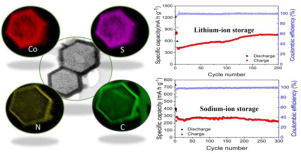Energy Storage Materials ( IF 18.9 ) Pub Date : 2019-01-26 , DOI: 10.1016/j.ensm.2019.01.012 Huihui Shangguan , Wei Huang , Christian Engelbrekt , Xiaowen Zheng , Fei Shen , Xinxin Xiao , Lijie Ci , Pengchao Si , Jingdong Zhang

|
Hollow nanostructured materials present a class of promising electrode materials for energy storage and conversion. Herein, 3D hollow nitrogen-doped carbon shells decorated with well-defined cobalt sulfide nanoparticles (Co9S8/HNCS) have been constructed for superior lithium and sodium storage. Two steps are involved in the designed preparation procedure. First, hollow intermediates with preserved cobalt components are controllably fabricated by simultaneously dissociating cobalt containing zeolitic-imidazolate-frameworks-67 (ZIF-67), and polymerizing dopamine in a Tris–HCl solution (pH = 8.5). The polydopamine (PDA) wrapped intermediates inherits the polyhedral structure of the ZIF-67 crystals. In the second step, the final Co9S8/HNCS composite is obtained via a combined carbonization and sulfurization treatment of the intermediates, allowing the formation of hollow polyhedrons of nitrogen-doped carbon shells (900±100 nm) derived from PDA and the encapsulation of highly uniform cobalt sulfide nanoparticles (11±2 nm). This configuration is believed to not only shorten the lithium or sodium ion diffusion distance and accommodate volume change during lithium or sodium ion insertion/extraction, but also to enhance the overall electrical conductivity and the number of active sites. As a result, the Co9S8/HNCS composite exhibits an impressive reversible capacity of 755 mA h g-1 at 500 mA g-1 after 200 cycles for lithium ion storage, and capacities of 327 mA h g-1 at 500 mA g-1 after 200 cycles and 224 mA h g-1 at 1000 mA g-1 after 300 cycles for sodium ion storage. Essential factors especially the structural stability during cycling have been identified, and the discharge/charge mechanism is discussed.
中文翻译:

定义明确的硫化钴纳米颗粒锁定在3D空心氮掺杂碳壳中,可实现出色的锂和钠存储
中空的纳米结构材料提供了用于能量存储和转换的一类有前途的电极材料。在此,已经构造了用明确定义的硫化钴纳米颗粒(Co 9 S 8 / HNCS)装饰的3D空心氮掺杂碳壳,以实现出色的锂和钠存储。设计的准备过程涉及两个步骤。首先,通过同时解离含沸石-咪唑盐-骨架67(ZIF-67)的钴,并在Tris-HCl溶液(pH = 8.5)中聚合多巴胺,可控制地制造具有保留的钴成分的中空中间体。聚多巴胺(PDA)包裹的中间体继承了ZIF-67晶体的多面体结构。第二步,最后的Co 9 S 8通过中间体的联合碳化和硫化处理获得/ HNCS复合材料,从而可以形成源自PDA的氮掺杂碳壳(900±100 nm)的空心多面体,并封装高度均匀的硫化钴纳米颗粒(11±2)纳米)。据信这种构型不仅缩短了锂或钠离子的扩散距离并适应了锂或钠离子插入/提取过程中的体积变化,而且还增强了整体电导率和活性位点的数量。结果,Co 9 S 8 / HNCS复合材料在200个锂离子存储循环后,在500 mA g -1时表现出令人印象深刻的755 mA hg -1的可逆容量,而容量为327 mA hg在200个循环后为-1,在500 mA g -1下,在300个循环后为在1000 mA,g -1为224 mA hg -1,用于钠离子存储。已经确定了主要因素,尤其是循环过程中的结构稳定性,并讨论了放电/充电机理。


















































 京公网安备 11010802027423号
京公网安备 11010802027423号